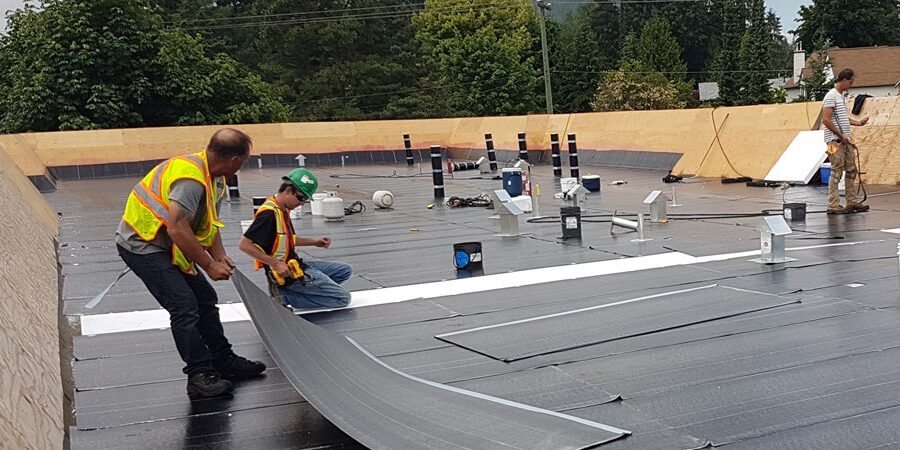Maintaining a flat roof is a crucial aspect of preserving the integrity of any building. Flat roofs are a popular choice for various structures, offering a sleek and modern aesthetic along with practical functionality. However, without proper care, they can be susceptible to various issues. In this comprehensive guide, we will delve into flat roof maintenance, covering everything from understanding different roofing materials to proactive strategies for preventing common problems.
Flat roof maintenance is an often overlooked yet essential task for homeowners and property managers alike. Unlike traditional pitched roofs, flat roofs present unique challenges and require specific care to ensure they remain in optimal condition. In this article, we will explore the key aspects of maintaining a flat roof, offering valuable insights to protect your investment and extend the life of your roof.
Understanding Flat Roof Maintenance Materials
Flat roofs come in various materials, each with its own set of advantages and disadvantages. EPDM, TPO, PVC, and Built-Up Roofing are among the most common. Choosing the right material for your flat roof is the first step in effective maintenance.
EPDM
EPDM, or Ethylene Propylene Diene Monomer, is a popular synthetic rubber roofing membrane. It is known for its durability and resistance to harsh weather conditions.
TPO
Thermoplastic Olefin, or TPO, is a single-ply roofing membrane that offers energy efficiency and resistance to UV radiation.
PVC
Polyvinyl Chloride (PVC) is another thermoplastic roofing material known for its durability and flexibility.
Built-Up Roofing
Built-Up Roofing (BUR) consists of multiple layers of bitumen and reinforcing fabrics, providing strength and durability.
Understanding the pros and cons of each material is crucial for tailoring your maintenance efforts to the specific needs of your flat roof maintenance.
Signs of Flat Roof Damage
Before delving into maintenance practices, it’s essential to recognize signs of potential damage. Identifying issues early on can prevent more significant problems down the line.
Identifying Leaks and Water Damage
Flat roofs are prone to leaks, especially around seams and flashing. Water stains on the ceiling or walls are clear indicators of a leak.
Inspecting for Cracks and Punctures
Regularly inspect the surface for cracks and punctures. These can compromise the integrity of the roofing material and lead to leaks.
Recognizing Signs of Wear and Tear
Visible wear and tear, such as blistering or surface erosion, can indicate the need for maintenance. Addressing these issues promptly can prevent further damage.
Importance of Regular Inspections
Regular inspections are the cornerstone of effective flat roof maintenance. Establishing a routine inspection schedule allows you to catch potential problems before they escalate.
Frequency of Roof Inspections
For optimal maintenance, conduct a visual inspection at least twice a year. Additionally, perform checks after severe weather events, such as storms or heavy rainfall.
Inspection Tips for Homeowners
Homeowners can perform basic inspections by checking for visible damage, clearing debris, and ensuring proper drainage. Look for signs of sagging or uneven areas.
Benefits of Early Problem Detection
Early detection of issues allows for timely repairs, preventing extensive damage and costly repairs. Proactive maintenance is key to longer-lasting flat roof maintenance.
Clearing Debris and Vegetation
One of the most common issues with flat roofs is the accumulation of debris and vegetation. Proper maintenance involves keeping the roof surface clear to ensure effective drainage and prevent damage.
The Impact of Debris on Flat Roof Maintenance Drainage
Leaves, branches, and other debris can obstruct drainage pathways, leading to water pooling on the roof. This standing water can accelerate wear and deterioration.
Tools and Methods for Safe Debris Removal
Regularly remove debris using a soft-bristle broom or a leaf blower. Avoid using sharp tools that could damage the roofing material.
How Vegetation Can Compromise Roof Integrity
Moss and algae can compromise the integrity of the roof. Use environmentally friendly cleaning solutions to remove vegetation and prevent regrowth.
Cleaning and Preventing Mold Growth
Mold growth on flat roofs is not only unsightly but can also lead to structural issues. Regular cleaning and preventative measures can keep mold at bay.
Understanding the Causes of Mold on Flat Roofs
Poor drainage, trapped moisture, and organic debris create an ideal environment for mold growth. Addressing these factors is crucial for prevention.
Safe Cleaning Solutions for Mold Removal
Use a mixture of water and mild detergent to clean mold. Avoid harsh chemicals that could damage the roofing material or harm the environment.
Tips for Preventing Mold Growth in the Future
Improve ventilation, address drainage issues promptly, and trim overhanging branches to prevent excess shade and moisture accumulation.
Maintaining Roof Drains and Gutters
Proper drainage is essential for flat roofs. Regular maintenance of roof drains and gutters is necessary to prevent water buildup and potential damage.
Importance of Proper Drainage for Flat Roofs
Flat roof maintenance relies on efficient drainage systems to prevent water pooling. Clogged drains can lead to leaks and compromise the structure.
Clearing and Cleaning Roof Drains
Regularly inspect and clear roof drains of debris. Ensure that water can flow freely to prevent backups and potential water damage.
Gutter Maintenance to Prevent Water Pooling
Keep gutters clear of debris and ensure they are securely attached. Well-maintained gutters contribute to proper water flow and prevent water from accumulating on the roof.
Repairing and Sealing Leaks
Addressing leaks promptly is crucial for preventing water damage to the interior of the building. Learn some basic techniques for DIY leak repair and when to seek professional help.
DIY Leak Repair Methods for Small Damages
Small leaks can often be repaired using roofing sealant or patch kits. Clean the area thoroughly before applying any sealant.
When to Call a Professional for Roof Repairs
For larger or complex leaks, or if you are unsure about the extent of the damage, it’s advisable to call a professional roofing contractor. They can assess the situation and provide effective solutions.
Importance of Prompt Leak Repairs
Delaying repairs can lead to more extensive damage and costly repairs. Addressing leaks promptly ensures the longevity of your flat roof maintenance.
UV Protection and Coating
Flat roofs are exposed to intense sunlight, making them vulnerable to UV damage. Learn about the importance of UV protection and the benefits of applying reflective roof coatings.
The Impact of UV Rays on Flat Roof Maintenance Materials
UV rays can cause deterioration and aging of roofing materials. Understanding this impact is essential for effective maintenance.
Applying UV-Protective Coatings
UV-protective coatings act as a barrier, reflecting sunlight and reducing heat absorption. These coatings can extend the lifespan of your flat roof maintenance.
Benefits of Reflective Roof Coatings
Besides UV protection, reflective coatings can improve energy efficiency by reducing the heat absorbed by the roof. This can contribute to lower cooling costs in the building.
Professional Flat Roof Maintenance Services
While DIY maintenance is valuable, there’s no substitute for professional inspections and maintenance services. Explore the benefits of hiring a qualified roofing contractor for your flat roof.
The Role of Professional Roof Inspections
Professional roof inspections go beyond what homeowners can do themselves. Experienced contractors can identify potential issues and provide expert recommendations.
Hiring a Qualified Roofing Contractor
When seeking a roofing contractor, ensure they are licensed, insured, and have experience with flat roof maintenance. Check references and reviews to make an informed decision.
Scheduled Maintenance Plans for Flat Roofs
Many roofing contractors offer scheduled maintenance plans. These plans include regular inspections, cleaning, and minor repairs, providing a proactive approach to flat roof care.
Frequently Asked Question
- Q: How often should I inspect my flat roof maintenance?
A: Inspecting your flat roof at least twice a year is recommended, ideally in the spring and fall. Additionally, perform checks after severe weather events to catch any potential issues early on.
- Q: What are the signs of a flat roof leak?
A: Signs of a flat roof leak include water stains on interior ceilings or walls, damp spots, or mold growth. Exterior signs may include cracked or blistered roofing material.
- Q: Can I perform my flat roof inspection?
A: Yes, homeowners can conduct basic flat roof inspections. Look for visible damage, clear debris, and ensure proper drainage. However, professional inspections are recommended for a more thorough assessment.
- Q: How can I prevent debris buildup on my flat roof?
A: Regularly clear debris using a soft-bristle broom or a leaf blower. Trim overhanging branches, and use gutter guards to prevent leaves from clogging drainage systems.
- Q: Are flat roofs more prone to leaks than pitched roofs?
A: While flat roofs can be more susceptible to leaks due to pooling water, proper maintenance and drainage management can significantly reduce the risk.
- Q: Can I walk on my flat roof for maintenance tasks?
A: Exercise caution when walking on a flat roof, as some materials may be more fragile. If in doubt, consult with a roofing professional. Consider using walkway pads or boards to distribute your weight.
- Q: How do I repair a small leak on my flat roof?
A: Clean the affected area thoroughly, and apply roofing sealant or a patch kit designed for your roofing material. Monitor the repaired area for any signs of further issues.
- Q: Do flat roofs require a special coating for UV protection?
A: Applying a UV-protective coating is beneficial for flat roofs exposed to intense sunlight. It helps reflect sunlight, reducing heat absorption and extending the lifespan of the roof.
- Q: Should I hire a professional for flat roof maintenance?
A: While homeowners can perform basic maintenance, hiring a professional roofing contractor for regular inspections and more complex tasks is advisable. Professionals have the expertise to identify potential issues early on.
- Q: What is the average lifespan of a flat roof with regular maintenance?
A: The lifespan of a flat roof can vary depending on the material used. With proper maintenance, flat roofs can last 20 years or more. Regular inspections and timely repairs are key to extending its lifespan.
Conclusion
In conclusion, flat roof maintenance is a vital aspect of preserving the longevity and durability of your property. By understanding the materials used, recognizing signs of damage, and implementing regular maintenance practices, you can extend the life of your flat roof and avoid costly repairs. Whether you opt for DIY maintenance or enlist the help of professionals, the key is to stay proactive and address issues promptly. Invest in the care of your flat roof now to enjoy its benefits for years to come.
In this comprehensive guide, we’ve covered various aspects of flat roof maintenance, ensuring that you are well-equipped to tackle the unique challenges presented by flat roofs. Remember, a well-maintained flat roof not only enhances the aesthetic appeal of your property but also protects your investment in the long run.







